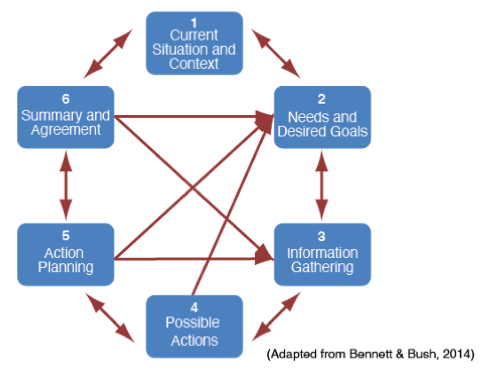The following is an excerpt from The Manager’s Guide to Coaching for Change (2024).
Having a process or model for coaching guides the coaching conversation, offers a proven approach that enhances credibility, is predictable for the person being coached, provides a sense of direction and comfort, and increases the likelihood that positive and productive outcomes will emerge. There are a variety of coaching models and processes.
One of the main tools that a manager-coach uses to help team members move through change is conversation. All coaching involves conversation, although other skills, including observation and assessment, are often leveraged to support the process. A coaching conversation’s predictable and purposeful structure makes it distinct from, say, a chat with a friend. The coaching conversation aims to provide a vehicle for forward movement while the chat can ramble and have little purpose other than creating or sustaining rapport. The purpose of a chat with a friend is not necessarily or predictably action oriented.
The Change Coaching Model illustrated in the figure below enables the manager as coach to guide the coaching conversations within this context (Bennett & Bush, 2014). The steps are:
- Current Situation and Context. This explores what is present for the team member, what has occurred since your last coaching conversation, and what progress they made toward previously established action plans.
- Needs and Desired Goals. This step involves helping the team member identify their goals for the current coaching conversation. This step often requires a great deal of discernment and clarification. There is a saying in management consulting that applies to coaching: The presenting issue is rarely the real issue.
- Information Gathering. This includes helping the team member discover things like what is known and unknown, what has been tried, lessons learned from previous experiences that may relate to the current agenda for coaching, resources available, impacts of actions and desired impacts, as well as identification of possible criteria for evaluating possible actions.
- Possible Actions. In this step, the manager-coach helps the team member identify possible actions they could take to address their goals/agenda. Then, you help the team member consider those actions and select the one(s) to act upon. You may offer ideas to help stimulate creativity by the team member, but it is crucial that the person being coached develop the possible action. Avoid telling the team member what to do.
- Action Planning. The team member should develop a specific action plan for each action they chose to implement. This should include what will be done, when, for what desired outcome, and with what support.
- Summary and Agreement. The final step in the change coaching process is to have the person being coached identify what they have gained from the coaching conversation and summarize the action plans they are committed to taking before the next coaching conversation or other mutually agreed-upon deadline.

Effective coaching conversations begin with Step 1 and end with Step 6. However, they are dynamic, and conversations are likely to flow back and forth through the intermediate steps as the manager-coach seeks to define, explore, and advance understanding of the team member’s issues.
These are descriptions of each step in the change coaching model and sample questions or statements to support each step. Manager-coaches will want to find language that is natural and comfortable for them.
Step 1: Current Situation and Context
The focus of this step is to establish or reestablish the relationship between manager and team member, and obtain an update from the team member on recent occurrences in the context of the coaching goals. In addition, this step is to assess progress on previous action-items, and acknowledge success and breakthroughs that may have occurred.
Suppose this is the first coaching session in a multi-session coaching engagement. The primary focus should be establishing the relationship and defining the engagement’s purpose, scope, and operating agreements. If this is a single-session coaching engagement, the relationship development and contracting, as well as the coaching process described here, will all occur in the single session. Sample questions that might be used with this step in the coaching process:
- How are you today?
- What has happened since we last met?
- What’s the most significant thing that happened to you today?
- What have you accomplished related to your action plans from the last time we met?
- What progress have you made since we spoke?
- What accomplishments (or setbacks) have you experienced since our last coaching session?
Step 2: Needs and Desired Goals
The focus of this step is for the coach to gain an understanding of the team member’s current reality, and to understand and agree upon the goals for the coaching session. You and the team member will also align those goals with the overall goals of the coaching engagement, and adjust the goals of the engagement if necessary. You and the team member will also adjust the goals of the overall engagement as the focus becomes clearer. This determination will be based on whether clarity and mutual understanding exist between the manager-coach and team members. You can align with the team member’s goals via conversation with the team member. Sample questions that might be used with this step in the coaching process:
- What are we going to focus on in this coaching session today?
- Of the __ things you mentioned that we might focus on today, which do you want to start with?
- What is essential for you to accomplish in our coaching work today?
- What will you have accomplished if this coaching session is a massive success?
- How would you rate this goal on a scale of 1-10 (10 being most important)?
- What would that look like if we were to “hit a home run” in this coaching session?
- For this coaching session, what will success look like for you?
Step 3: Information Gathering
The focus of this step is to gather information that serves the team member’s agenda, gain a mutual understanding of that information, and identify the need for additional data (which may become an action item for later consideration). As the process manager, the coach must determine whether the conversation has developed enough information and shared understanding to progress to Step 4 (Possible Actions). If not, it must go back to Step 2 to refine Needs and Desired Goals. Sample questions that might be used with this step in the coaching process:
- How important is that to you?
- How is your behavior impacting others?
- What does that feedback mean to you?
- In what, if any, ways are you rushing to judgment?
- What are you missing?What matters most?
- What are you inclined to believe about ___?
- What is the opposing view?
- Which of the conflicting views has more evidence behind it?
- What are you afraid of and why?
Step 4: Possible Actions
This step focuses on exploring possibilities for action that will serve the team member’s needs and desired goals for the coaching session. The team member generates ideas for possible action, establishes criteria to evaluate those options, considers barriers to implementing them, and establishes priorities for action. Sample questions that might be used with this step in the coaching process:
- How might you improve the situation?
- What possible actions have you not explored?
- What have you seen others do that might work here?
- If none of the current options were available, what would you do?
- What is the counterintuitive choice?
- What would an outsider do?
- What ideas do you have for addressing this?
- How will you decide which step to take next?
- What has worked for you in the past?
- Offer (sparingly) ideas or questions to “prime the pump.”
The manager-coach will need to determine whether to progress to Step 5 (Action Planning), go back to a previous step (Information Gathering, Needs and Desired Goals), or continue developing possible actions. This determination will be based on whether there is a clear understanding of the information available, possible actions to support achieving the desired goals, and a commitment to consider action steps for implementation.
Step 5: Action Planning
The focus of this step is to develop action steps (what the team member will do, by when, with what outcome, and with what support), ensure accountability and commitment for implementation, and determine resource and support needs as well as how to acquire those resources. Sample questions that could be used with this step in the coaching process:
- What action will you take?
- What support do you need?
- What are you committed to doing? By when?
- What support do you have that you will call on to accomplish your action plan?
- What challenges or barriers do you anticipate, and how will you address them?
- What support will you access to achieve your action plans?
- What support do you have in place to help you?
- What support do you need? What will you do to secure it?
The manager-coach will need to determine whether to progress to Step 6 (Summary and Agreement), go back to a previous step (Information Gathering, Needs and Desired Goals, Possible Actions), or continue developing possible actions. This determination will be based on whether the team member is clear about and committed to the action steps designed, and whether there is agreement about what the team member will do next—by when, and with what support (if appropriate).
Step 6: Summary and Agreement
The focus of this step is to review insights and commitments gained from this coaching session, identify possible agenda items for future coaching sessions, and reinforce that the team member owns the coaching agenda and actions. Sample questions that might be used with this step in the coaching process:
- What have you gained from this conversation?
- What are your key takeaways from our work today?
- What are your next steps?
- What are you committed to doing?
- What will you do as a result of this coaching session?
- What did you gain from this coaching session?
- Please remind me. What will you do as a result of this coaching session?
The manager-coach will need to determine whether to end the coaching session or return to a previous step in the coaching process (Information Gathering, Needs and Desired Goals, Possible Actions, Action Planning). This determination will be based on whether there is shared agreement about the next steps, whether the designated length of the coaching session has ended, and whether a new area of focus has emerged.
For more information about coaching, purchase my book, The Manager’s Guide to Coaching for Change (2024).
Photo by Kanhaiya Sharma on Unsplash
___________
© 2024, John L. Bennett. All Rights Reserved.

